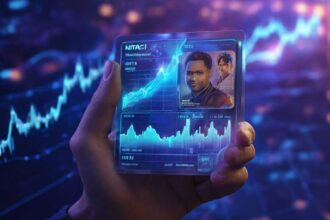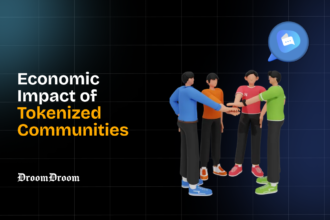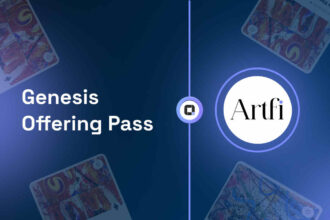Have you ever wondered how to create your digital art gallery and sell your artworks as NFTs (non-fungible tokens) on the blockchain? In this article, we will show you 10 easy steps to build a full stack web3 app that allows you to create, display, and trade your NFT artworks on the internet, with loads of software and plug-in recommendations.
- Letting You in on The Basics of NFT Art Gallery, Full-stack Web3 App (dApp)
- Step-by-Step Guide: Let’s Dive Right Into it
- Step 1: Set the Stage – Pick Your Blockchain and Smart Contract Language.
- Step 2: Design and Mint
- Step 3: Design a Front-end Interface–Make it Look Good
- Step 4: Add Features and Functionalities
- Step 5: Buy and Sell–Implement a Payment System and Marketplace
- Step 6: Share the Love–Add Comments, Ratings, Reviews, and Sharing
- Step 7: Testing the Waters–Test and Debug Time
- Step 8: Deploy and Host: It’s Mainnet Time
- Step 9: Promotion and Marketing and monetization
- Step 10: Update and Maintain with Version Control
- What are the best practices for web3 app security and scalability?
- A Sneak Peek into the Future of Digital Art Galleries
- Conclusion
To build a web3 app (dApp) for your NFT art gallery, you need to follow 10 easy steps that involve choosing a blockchain platform and a smart contract language, designing and minting your NFT artworks, writing, compiling, deploying, and testing your smart contract, creating and connecting your frontend user interface, and deploying your web3 app to the mainnet.
Letting You in on The Basics of NFT Art Gallery, Full-stack Web3 App (dApp)
For ease in navigating this tutorial, we’ll begin by reacquainting ourselves with a few norm jargon.
Web3 is the next generation of the web, and rightly so because users have more control, privacy, and ownership of their data and assets. DApps (decentralized applications), on the other hand, are web3 apps that run on a distributed network of computers, without relying on a central authority or intermediary.
Non-fungible tokens (NFTs), like CryptoKitties and Nyan Cat GIF, are simply a type of digital asset used to show proof of ownership of a particular item. They are not not exchangeable on a like-for-like basis, hence we say they are unique.
As an enterprising developer, many benefits abound when you successfully build a dApp. One, you can take advantage of the transparency, security, and immutability that blockchain technology offers. And two you can and should also tap into the growing market of NFTs, which is over a whopping $40.5 billion TVL.
Step-by-Step Guide: Let’s Dive Right Into it
To successfully appreciate this next section, the user must have some basic coding knowledge. But not to worry, if you’re a newbie to ‘codenomics’, this section has been deliberately de-technicalized for you, to a high extent, with less jargon than it’s usual.
Also for ease of understanding, we’re assuming for this tutorial that our project is an NFT art gallery.
Armed with all these, we can begin.
To keep it simple, a full stack web3 app consists of a frontend user interface that interacts with a backend smart contract. Is like the visible part (front-end) and invisible (backend) part of the project.
Learn more about digital arts: Decoding NFTs: A Comprehensive Guide To Digital Art
To create your web3 app you will need to follow these 10 simplified basic steps:
Step 1: Set the Stage – Pick Your Blockchain and Smart Contract Language.
First things first, they say, so, choose a blockchain platform and a smart contract language.
A blockchain platform is simply a network of computers that run a shared set of rules and store data in a distributed ledger—more like playing Scrabble with friends but everyone gets to write their scores themselves in their notepad. On the other hand, a smart contract is a piece of code that runs on the blockchain and defines the logic and rules for the project to be executed, in this case, the NFT art gallery.
There are many blockchain platforms and smart contract languages to choose from, but for this tutorial, we will use Ethereum, which is the most popular and widely used platform for web3 and NFTs. Ethereum has its native cryptocurrency, called Ether (ETH). This is the currency to pay for transactions and smart contract execution on this network. Ethereum also has its smart contract language, called Solidity, which is similar to JavaScript and easy to learn. That’s what we’ll be using too. To get started with Ethereum and Solidity, you will need to install some tools and libraries. They are:
– Node.js and NPM— used to run JavaScript code and manage packages.
– Ganache— is a local blockchain simulator that allows you to test your smart contracts and web3 app without connecting to the main Ethereum network.
– Truffle— is a framework that helps you write, compile, deploy, and test your smart contracts.
– Metamask— is a browser extension that allows you to interact with Ethereum and web3 apps from your browser. Metamask also acts as a wallet that stores your ETH and NFTs.
Google them out, and install them.
To know more about Metamask, We recommend reading this article: MetaMask: The Most Popular Wallet
Step 2: Design and Mint
Once step one is completed, the next step is to design and mint your own NFT artwork using tools like Photoshop, Illustrator, or Blender. Remember I said that this project is to develop your NFT Art Gallery (a dApp). Here, you will use your creativity and skills to create the digital artwork that you want to sell as NFTs. The software above which I assume you are familiar with will come in handy. Use any of them to design your artwork. If you’re not a software person, maybe you can try out online platforms or generators, such as Artbreeder, Pexels, or OpenAI, to create or enhance your artwork.
Whatever style you choose to adopt, ensure your artwork is in a digital format, such as JPG, PNG, GIF, or MP4.
Once you have created your artwork, you will need to mint them as NFTs. Minting is just a fancy word to describe the process of creating and registering your NFTs on the blockchain, using a smart contract. To mint, write a Solidity smart contract, deploy it with Truffle, and mint your NFTs using Web3.js or Ethers.js.
Step 3: Design a Front-end Interface–Make it Look Good
Two steps down, the next, is to create the user interface, aka front-end, of your web3 app using HTML, CSS, and JavaScript. This is like the face of your dApps which allow users to view, buy, and sell your NFT artworks on the internet.
To create your front-end interface, explore simple these steps:
- First, create an HTML file that defines the structure and elements of your web app, such as the header, footer, navigation, gallery, and modal. You can use a template or a framework, such as Bootstrap or Tailwind, to speed up the process and make your web app responsive and mobile-friendly.
- Next, create a CSS file that defines the style and appearance of your web app, such as the colors, fonts, margins, and animations. You can also use a preprocessor, such as Sass or Less, to write more concise and modular code, and a compiler, such as Babel or Webpack, to convert your code into browser-compatible code.
- Lastly, create a JavaScript file that defines the logic and behavior of your web app, such as fetching, displaying, and updating data, handling user input and events, and calling smart contract functions. At this point, you can also use a library or a framework, such as React or Vue, to create more dynamic and interactive web app components, and a state management tool, such as Redux or Vuex, to manage and share data across your web app.
All the software and apps mentioned above and hereafter are recommendations only. They are based on research, popular use, and opinions. But feel free to stick with what works for you as a developer.
Step 4: Add Features and Functionalities
At this stage, the goal is to enhance the user experience of your web3 app by adding more features and functionalities that allow users to browse, filter, sort, and search for artworks in your NFT art gallery. You will use APIs and databases to fetch and display data from the blockchain, such as the name, description, image, price, and owner of each NFT. You will also use JavaScript and Web3.js or Ethers.js to implement the logic and behavior of these features and functionalities.
To add features and functionalities to your NFT art gallery, follow these steps:
- Create an API that connects to the blockchain and queries data from your smart contract, using a tool or a service, such as Moralis, The Graph, or Infura.
- Create a database that stores and manages data from your API, using a tool or a service, such as MongoDB, Firebase, or Airtable.
- You’ll need a gallery component that displays the data from your database, using HTML, CSS, and JavaScript.
- Add a filter component that allows users to filter the NFTs by different criteria, such as category, rarity, or price range, using HTML, CSS, and JavaScript.
- Create a sort component that allows users to sort the NFTs by different criteria, such as name, date, or popularity, using HTML, CSS, and JavaScript.
- Create a search component that allows users to search for NFTs by keywords or phrases.
Step 5: Buy and Sell–Implement a Payment System and Marketplace
To implement a payment system and a marketplace for your NFT art gallery means setting up a system that enables users to buy and sell your NFT artworks on the blockchain, using cryptocurrencies and tokens. For this, you will use Web3.js or Ethers.js to interact with your smart contract and execute transactions on the blockchain. You will also use Moralis or OpenSea to integrate your web app with a marketplace that allows users to discover, bid, and trade your NFTs.
To implement a payment system and a marketplace for your NFT art gallery, here are a few easy steps to follow:
- Build a payment feature for buying and selling NFTs. Design a button to start transactions, and a popup displaying transaction details like price and gas fee. Connect with Web3.js or Ethers.js to use Metamask for blockchain transactions.
- Create a marketplace feature for users to list and trade NFTs using Moralis or OpenSea. Add a button for listing, a modal with details like name, description, and price, and connect everything via API or SDK, to manage listings on the platform.
Read this article to learn about the best NFT marketplaces: The Top NFT Marketplaces.
Step 6: Share the Love–Add Comments, Ratings, Reviews, and Sharing
Adding social and interactive elements to your NFT art gallery, like comments, ratings, reviews, and sharing should make your web3 app more engaging and fun so much so that users find it convenient to communicate and collaborate with the artists seamlessly. What you need to do at this stage is to use Web3 protocols and platforms, like Steemit, Livepeer, or 3Box, to enable decentralized communication and collaboration among users and artists in your gallery (dApps). However, you will also need to use HTML, CSS, and JavaScript to create the user interface and functionality of these elements.
Step 7: Testing the Waters–Test and Debug Time
You come a long way at this point in this full-stack web3 app tutorial. You’re almost there. This is the test stage and debug your NFT art gallery to ensure the security and functionality of the app and smart contracts. Tools like Ganache, Truffle, or Remix, which are the same tools that you used to write, compile, and deploy your smart contracts will be very handy. You will also require the aid of JavaScript and Web3.js or Ethers.js again, this time, to write and run test cases and scenarios for your web app.
Please note that Ethereum has different testnets (Ropsten, Rinkeby, Kovan) for development and testing before deploying on the mainnet.
Moving on, follow the following steps to test and debug your NFT art gallery:
- Create a test file with JavaScript and Web3.js or Ethers.js to outline smart contract test cases. Utilize Mocha, Chai, or Jest as a testing framework. Employ assertions (e.g., assert, expect) to confirm test outcomes. Consider streamlining with tools like OpenZeppelin Test Helpers or Waffle.
- Execute your test file on the Ganache local blockchain through Truffle. This runs test cases, providing a report on success or failure. Review transaction details and logs. Tools like Truffle Debugger or Remix Debugger aid in inspecting, debugging, and fixing errors or bugs in your smart contracts and transactions, at this stage.
- Create a JavaScript test file for your web app using Web3.js or Ethers.js. Utilize Cypress, Selenium, or Puppeteer for automated tests, ensuring outcome verification with assertions. Test your app on public networks like Rinkeby, Ropsten, or Kovan, using tools like Moralis Speedy Nodes or Infura Testnet to mimic the main Ethereum network with simulated ETH and NFTs.
- Run your test file in your web browser with Cypress, Selenium, or Puppeteer. It executes test cases on your web app, reporting success or failure. View details and logs of each action and event during the test. Utilize Chrome DevTools or Firefox Developer Tools to inspect, debug, and fix errors or bugs in your web and web3 app components.
Step 8: Deploy and Host: It’s Mainnet Time
In this step, you will make your web3 app accessible and available to the public by deploying and hosting it on the mainnet. A main network is a blockchain network that is used for real transactions and applications. Deploying your smart contract on a main network means making it available and usable by anyone on the blockchain.
You will use services like Netlify, Vercel, or IPFS, which are platforms that provide easy and fast hosting and deployment of web apps, without requiring you to set up or maintain your server. You will also use domain registrars and DNS providers to set up a custom domain name and an SSL certificate for your web app, which will make your web app more professional and secure.
To go live with your NFT art gallery, follow these procedures:
- Sign up on Netlify, Vercel, or IPFS, using GitHub, GitLab, or Bitbucket. Connect your code repository and deploy your web app to the internet effortlessly. Choose the repository, and branch, and configure build settings with environment variables like API key, database key, and smart contract details. Obtain a URL for your deployed web app, e.g., https://your-project-name.netlify.app, https://your-project-name.vercel.app, or .
- Sign up on a domain registrar like Namecheap, GoDaddy, or Google Domains. Secure your unique domain, e.g., https://your-domain-name.com, for your web app. Search for an available domain, pay a small annual fee, and obtain DNS records like A, CNAME, or TXT for your domain.
- Sign up on a DNS provider like Cloudflare, AWS, or Google Cloud. Obtain an SSL certificate for secure communication. Add and verify your domain on the platform, configuring DNS records and SSL settings, including type, mode, and expiration.
Step 9: Promotion and Marketing and monetization
Now that you successfully developed your NFT gallery dApp, the point of call is to give it visibility in the digital space. Promote and market your NFT art gallery using social media, blogs, podcasts, or newsletters. This is the stage to attract and retain more users and customers for your web3 app as it’s practically possible, by promoting and marketing your NFT art gallery on the internet. You will use social media, blogs, podcasts, or newsletters to create and share content that showcases your NFT artworks, tells your story, and engages your audience. You will also use SEO and analytics tools to optimize your web app for search engines and track your web traffic and user behavior.
Step 10: Update and Maintain with Version Control
Keeping your NFT art gallery up-to-date with web3 and NFT trends by utilizing version control platforms like GitHub, GitLab, or Bitbucket is a crucial final step in your dApp development journey. The smooth execution, running, and security of your project is hinged on this last step.
For this, you will need HTML, CSS, JavaScript, and Web3.js or Ethers.js to edit and enhance your code and project files regularly.
Here is a quick idea on how to keep your dApp updated:
On GitHub, GitLab, or Bitbucket:
- Set up a repository and branch for your web3 app using your account and project name. These platforms manage your code on a remote server, tracking its changes and history. Create a repository for your app code and project files, along with a branch for editing without affecting the main branch.
- Save and upload your web3 app code and files to the repository and branch using Git commands like git add, git commit, and git push. Include a message and tag describing your changes.
- Review, approve, and apply changes to your main branch and deployed web app by creating a pull request or merge request on the platform interface. Use a title and description summarizing the updates made to your code and project files.
What are the best practices for web3 app security and scalability?
Web3 app development involves some unique challenges and opportunities in terms of security and scalability. Here are some best practices to consider when building web3 apps:
- Ensure secure coding with tools like Solidity linters, analyzers, and testing frameworks to enhance smart contract code quality. Implement robust authentication using cryptographic signatures and access controls for user protection.
- Safeguard user keys with secure management solutions like hardware wallets or web3 providers. Regularly monitor and test web3 app performance using tools like analytics platforms and bug reporting services.
- Enhance web3 app communication with secure networking practices such as HTTPS and TLS. Stay current on web3 security trends via blogs, podcasts, and forums to adopt new solutions and innovations.
A Sneak Peek into the Future of Digital Art Galleries
Conclusion
Congratulations, you have successfully built your own NFT art gallery as a full-stack web3 app. You have learned how to use various tools and technologies, such as Ethereum, Solidity, Web3.js, Ethers.js, Moralis, OpenSea, Steemit, Livepeer, and more, to create, display, and trade your NFT artworks on the blockchain. You have also learned how to design, develop, test, deploy, and market your web3 app, and how to add features and functionalities that enhance the user experience and engagement.
By building a web3 app, you have taken advantage of the benefits of blockchain technology and also tapped into the over $40 billion growing market of NFTs, which are important for the future of art and the internet.




















